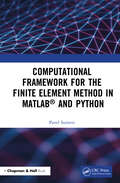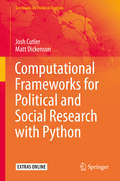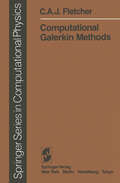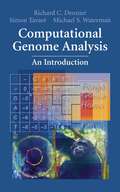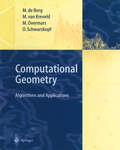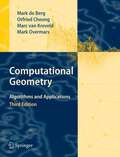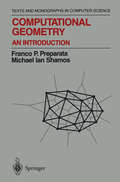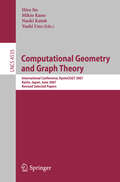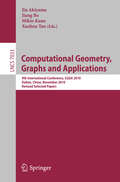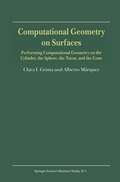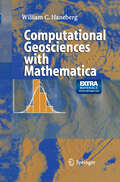- Table View
- List View
Computational Framework for the Finite Element Method in MATLAB® and Python
by Pavel SumetsComputational Framework for the Finite Element Method in MATLAB® and Python aims to provide a programming framework for coding linear FEM using matrix-based MATLAB® language and Python scripting language. It describes FEM algorithm implementation in the most generic formulation so that it is possible to apply this algorithm to as many application problems as possible. Readers can follow the step-by-step process of developing algorithms with clear explanations of its underlying mathematics and how to put it into MATLAB and Python code. The content is focused on aspects of numerical methods and coding FEM rather than FEM mathematical analysis. However, basic mathematical formulations for numerical techniques which are needed to implement FEM are provided. Particular attention is paid to an efficient programming style using sparse matrices. Features Contains ready-to-use coding recipes allowing fast prototyping and solving of mathematical problems using FEM Suitable for upper-level undergraduates and graduates in applied mathematics, science or engineering Both MATLAB and Python programming codes are provided to give readers more flexibility in the practical framework implementation
Computational Framework for the Finite Element Method in MATLAB® and Python
by Pavel SumetsComputational Framework for the Finite Element Method in MATLAB® and Python aims to provide a programming framework for coding linear FEM using matrix-based MATLAB® language and Python scripting language. It describes FEM algorithm implementation in the most generic formulation so that it is possible to apply this algorithm to as many application problems as possible. Readers can follow the step-by-step process of developing algorithms with clear explanations of its underlying mathematics and how to put it into MATLAB and Python code. The content is focused on aspects of numerical methods and coding FEM rather than FEM mathematical analysis. However, basic mathematical formulations for numerical techniques which are needed to implement FEM are provided. Particular attention is paid to an efficient programming style using sparse matrices. Features Contains ready-to-use coding recipes allowing fast prototyping and solving of mathematical problems using FEM Suitable for upper-level undergraduates and graduates in applied mathematics, science or engineering Both MATLAB and Python programming codes are provided to give readers more flexibility in the practical framework implementation
Computational Frameworks for Political and Social Research with Python (Textbooks on Political Analysis)
by Josh Cutler Matt DickensonThis book is intended to serve as the basis for a first course in Python programming for graduate students in political science and related fields. The book introduces core concepts of software development and computer science such as basic data structures (e.g. arrays, lists, dictionaries, trees, graphs), algorithms (e.g. sorting), and analysis of computational efficiency. It then demonstrates how to apply these concepts to the field of political science by working with structured and unstructured data, querying databases, and interacting with application programming interfaces (APIs). Students will learn how to collect, manipulate, and exploit large volumes of available data and apply them to political and social research questions. They will also learn best practices from the field of software development such as version control and object-oriented programming. Instructors will be supplied with in-class example code, suggested homework assignments (with solutions), and material for practical lab sessions.
Computational Galerkin Methods (Scientific Computation)
by C. A. FletcherIn the wake of the computer revolution, a large number of apparently uncon nected computational techniques have emerged. Also, particular methods have assumed prominent positions in certain areas of application. Finite element methods, for example, are used almost exclusively for solving structural problems; spectral methods are becoming the preferred approach to global atmospheric modelling and weather prediction; and the use of finite difference methods is nearly universal in predicting the flow around aircraft wings and fuselages. These apparently unrelated techniques are firmly entrenched in computer codes used every day by practicing scientists and engineers. Many of these scientists and engineers have been drawn into the computational area without the benefit offormal computational training. Often the formal computational training we do provide reinforces the arbitrary divisions between the various computational methods available. One of the purposes of this monograph is to show that many computational techniques are, indeed, closely related. The Galerkin formulation, which is being used in many subject areas, provides the connection. Within the Galerkin frame-work we can generate finite element, finite difference, and spectral methods.
Computational Genome Analysis: An Introduction
by Richard C. Deonier Simon Tavaré Michael S. WatermanThis book presents the foundations of key problems in computational molecular biology and bioinformatics. It focuses on computational and statistical principles applied to genomes, and introduces the mathematics and statistics that are crucial for understanding these applications. The book features a free download of the R software statistics package and the text provides great crossover material that is interesting and accessible to students in biology, mathematics, statistics and computer science. More than 100 illustrations and diagrams reinforce concepts and present key results from the primary literature. Exercises are given at the end of chapters.
Computational Geometry: Algorithms and Applications
by Mark de Berg Marc van Kreveld Mark Overmars Otfried SchwarzkopfComputational geometry emerged from the field of algorithms design and anal ysis in the late 1970s. It has grown into a recognized discipline with its own journals, conferences, and a large community of active researchers. The suc cess of the field as a research discipline can on the one hand be explained from the beauty of the problems studied and the solutions obtained, and, on the other hand, by the many application domains--computer graphics, geographic in formation systems (GIS), robotics, and others-in which geometric algorithms play a fundamental role. For many geometric problems the early algorithmic solutions were either slow or difficult to understand and implement. In recent years a number of new algorithmic techniques have been developed that improved and simplified many of the previous approaches. In this textbook we have tried to make these modem algorithmic solutions accessible to a large audience. The book has been written as a textbook for a course in computational geometry, but it can also be used for self-study.
Computational Geometry: Algorithms and Applications
by Mark de Berg Otfried Cheong Marc van Kreveld Mark OvermarsThis introduction to computational geometry focuses on algorithms. Motivation is provided from the application areas as all techniques are related to particular applications in robotics, graphics, CAD/CAM, and geographic information systems. Modern insights in computational geometry are used to provide solutions that are both efficient and easy to understand and implement.
Computational Geometry: An Introduction (Monographs in Computer Science)
by Franco P. Preparata Michael I. ShamosFrom the reviews: "This book offers a coherent treatment, at the graduate textbook level, of the field that has come to be known in the last decade or so as computational geometry. ... ... The book is well organized and lucidly written; a timely contribution by two founders of the field. It clearly demonstrates that computational geometry in the plane is now a fairly well-understood branch of computer science and mathematics. It also points the way to the solution of the more challenging problems in dimensions higher than two." #Mathematical Reviews#1 "... This remarkable book is a comprehensive and systematic study on research results obtained especially in the last ten years. The very clear presentation concentrates on basic ideas, fundamental combinatorial structures, and crucial algorithmic techniques. The plenty of results is clever organized following these guidelines and within the framework of some detailed case studies. A large number of figures and examples also aid the understanding of the material. Therefore, it can be highly recommended as an early graduate text but it should prove also to be essential to researchers and professionals in applied fields of computer-aided design, computer graphics, and robotics." #Biometrical Journal#2
Computational Geometry and Graph Theory: International Conference, KyotoCGGT 2007, Kyoto, Japan, June 11-15, 2007. Revised Selected Papers (Lecture Notes in Computer Science #4535)
by Hiro Ito Mikio Kano Naoki Katoh Yushi UnoThis book constitutes the thoroughly refereed post-conference proceedings of the Kyoto Conference on Computational Geometry and Graph Theory, KyotoCGGT 2007, held in Kyoto, Japan, in June 2007, in honor of Jin Akiyama and Vašek Chvátal, on the occasion of their 60th birthdays. The 19 revised full papers, presented together with 5 invited papers, were carefully selected during two rounds of reviewing and improvement from more than 60 talks at the conference. All aspects of Computational Geometry and Graph Theory are covered, including tilings, polygons, impossible objects, coloring of graphs, Hamilton cycles, and factors of graphs.
Computational Geometry, Graphs and Applications: International Conference,CGGA 2010, Dalian, China, November 3-6, 2010, Revised, Selected Papers (Lecture Notes in Computer Science #7033)
by Jin Akiyama Jiang Bo Mikio Kano Xuehou TanThis book constitutes the thoroughly refereed post-conference proceedings of the China-Japan Joint Conference on Computational Geometry, Graphs and Applications, CGGA 2010, held in Dalian, China, in November 2010. The 23 revised full papers presented were carefully selected during two rounds of reviewing and improvement from numerous submissions. All aspects of computational and discrete geometry, graph theory, graph algorithms, and their applications are covered.
Computational Geometry on Surfaces: Performing Computational Geometry on the Cylinder, the Sphere, the Torus, and the Cone
by Clara I. Grima Alberto MárquezIn the last thirty years Computational Geometry has emerged as a new discipline from the field of design and analysis of algorithms. That dis cipline studies geometric problems from a computational point of view, and it has attracted enormous research interest. But that interest is mostly concerned with Euclidean Geometry (mainly the plane or Eu clidean 3-dimensional space). Of course, there are some important rea sons for this occurrence since the first applieations and the bases of all developments are in the plane or in 3-dimensional space. But, we can find also some exceptions, and so Voronoi diagrams on the sphere, cylin der, the cone, and the torus have been considered previously, and there are manY works on triangulations on the sphere and other surfaces. The exceptions mentioned in the last paragraph have appeared to try to answer some quest ions which arise in the growing list of areas in which the results of Computational Geometry are applicable, since, in practiee, many situations in those areas lead to problems of Com putational Geometry on surfaces (probably the sphere and the cylinder are the most common examples). We can mention here some specific areas in which these situations happen as engineering, computer aided design, manufacturing, geographie information systems, operations re search, roboties, computer graphics, solid modeling, etc.
Computational Geosciences with Mathematica
by William HanebergComputational Geosciences with Mathematica is the only book written by a geologist specifically to show geologists and geoscientists how to use Mathematica to formulate and solve problems. It spans a broad range of geologic and mathematical topics, which are drawn from the author's extensive experience in research, consulting, and teaching. The reference and text leads readers step-by-step through geologic applications such as custom graphics programming, data input and output, linear and differential equations, linear and nonlinear regression, Monte Carlo simulation, time series and image analysis, and the visualization and analysis of geologic surfaces. It is packed with actual Mathematica output and includes boxed Computer Notes with tips and exploration suggestions.
Computational Granular Dynamics: Models and Algorithms
by Thorsten Pöschel T. SchwagerComputer simulations not only belong to the most important methods for the theoretical investigation of granular materials, but provide the tools that have enabled much of the expanding research by physicists and engineers. The present book is intended to serve as an introduction to the application of numerical methods to systems of granular particles. Accordingly emphasis is on a general understanding of the subject rather than on the presentation of latest advances in numerical algorithms. Although a basic knowledge of C++ is needed for the understanding of the numerical methods and algorithms in the book, it avoids usage of elegant but complicated algorithms to remain accessible for those who prefer to use a different programming language. While the book focuses more on models than on the physics of granular material, many applications to real systems are presented.
Computational Graph Theory (Computing Supplementa #7)
by Rudolf AlbrechtOne ofthe most important aspects in research fields where mathematics is "applied is the construction of a formal model of a real system. As for structural relations, graphs have turned out to provide the most appropriate tool for setting up the mathematical model. This is certainly one of the reasons for the rapid expansion in graph theory during the last decades. Furthermore, in recent years it also became clear that the two disciplines of graph theory and computer science have very much in common, and that each one has been capable of assisting significantly in the development of the other. On one hand, graph theorists have found that many of their problems can be solved by the use of com puting techniques, and on the other hand, computer scientists have realized that many of their concepts, with which they have to deal, may be conveniently expressed in the lan guage of graph theory, and that standard results in graph theory are often very relevant to the solution of problems concerning them. As a consequence, a tremendous number of publications has appeared, dealing with graphtheoretical problems from a computational point of view or treating computational problems using graph theoretical concepts.
Computational History and Data-Driven Humanities: Second IFIP WG 12.7 International Workshop, CHDDH 2016, Dublin, Ireland, May 25, 2016, Revised Selected Papers (IFIP Advances in Information and Communication Technology #482)
by Bojan Bozic, Gavin Mendel-Gleason, Christophe Debruyne and Declan O'SullivanThis book constitutes the refereed post-proceedings of the Second IFIP WG 12.7 International Workshop on Computational History and Data-Driven Humanities, held in Dublin, Ireland, in May 2016.The 7 full papers presented together with 2 invited talks and 4 lightning talks were carefully reviewed and selected from 14 submissions. The papers focus on the challenge and opportunities of data-driven humanities and cover topics at the interface between computer science, social science, humanities, and mathematics.
Computational Homogenization of Heterogeneous Materials with Finite Elements (Solid Mechanics and Its Applications #258)
by Julien YvonnetThis monograph provides a concise overview of the main theoretical and numerical tools to solve homogenization problems in solids with finite elements. Starting from simple cases (linear thermal case) the problems are progressively complexified to finish with nonlinear problems. The book is not an overview of current research in that field, but a course book, and summarizes established knowledge in this area such that students or researchers who would like to start working on this subject will acquire the basics without any preliminary knowledge about homogenization. More specifically, the book is written with the objective of practical implementation of the methodologies in simple programs such as Matlab. The presentation is kept at a level where no deep mathematics are required.
Computational Homology (Applied Mathematical Sciences #157)
by Tomasz Kaczynski Konstantin Mischaikow Marian MrozekHomology is a powerful tool used by mathematicians to study the properties of spaces and maps that are insensitive to small perturbations. This book uses a computer to develop a combinatorial computational approach to the subject. The core of the book deals with homology theory and its computation. Following this is a section containing extensions to further developments in algebraic topology, applications to computational dynamics, and applications to image processing. Included are exercises and software that can be used to compute homology groups and maps. The book will appeal to researchers and graduate students in mathematics, computer science, engineering, and nonlinear dynamics.
Computational Inelasticity (Interdisciplinary Applied Mathematics #7)
by J.C. Simo T.J.R. HughesA description of the theoretical foundations of inelasticity, its numerical formulation and implementation, constituting a representative sample of state-of-the-art methodology currently used in inelastic calculations. Among the numerous topics covered are small deformation plasticity and viscoplasticity, convex optimisation theory, integration algorithms for the constitutive equation of plasticity and viscoplasticity, the variational setting of boundary value problems and discretization by finite element methods. Also addressed are the generalisation of the theory to non-smooth yield surface, mathematical numerical analysis issues of general return mapping algorithms, the generalisation to finite-strain inelasticity theory, objective integration algorithms for rate constitutive equations, the theory of hyperelastic-based plasticity models and small and large deformation viscoelasticity. Of great interest to researchers and graduate students in various branches of engineering, especially civil, aeronautical and mechanical, and applied mathematics.
Computational Information Geometry: For Image and Signal Processing (Signals and Communication Technology)
by Frank Nielsen Frank Critchley Christopher T. DodsonThis book focuses on the application and development of information geometric methods in the analysis, classification and retrieval of images and signals. It provides introductory chapters to help those new to information geometry and applies the theory to several applications. This area has developed rapidly over recent years, propelled by the major theoretical developments in information geometry, efficient data and image acquisition and the desire to process and interpret large databases of digital information. The book addresses both the transfer of methodology to practitioners involved in database analysis and in its efficient computational implementation.
Computational Intelligence: International Conference on Intelligent Computing, ICIC 2006, Kunming, China, August 16-19, 2006, Proceedings, Part II (Lecture Notes in Computer Science #4114)
by De-Shuang Huang George William IrwinThis is the proceedings of the International Conference on Intelligent Computing, ICIC 2006, Kunming, China, August 2006. The book presents 165 revised full papers, carefully chosen and reviewed, organized in topical sections on fuzzy systems, fuzzy-neuro-evolutionary hybrids, supervised, unsupervised and reinforcement learning, intelligent agent and Web applications, intelligent fault diagnosis, natural language processing and expert systems, natural language human-machine interface using artificial neural networks, and intelligent financial engineering.
Computational Intelligence: Eine methodische Einführung in Künstliche Neuronale Netze, Evolutionäre Algorithmen, Fuzzy-Systeme und Bayes-Netze (Computational Intelligence)
by Rudolf Kruse Christian Borgelt Christian Braune Frank Klawonn Christian Moewes Matthias SteinbrecherDie Autoren behandeln umfassend zentrale Themen der Informatik von Künstlichen Neuronalen Netzen, über Evolutionäre Algorithmen bis hin zu Fuzzy-Systemen und Bayes-Netzen. Denn: Der Anwendungsbereich „Computational Intelligence“ erlangt durch viele erfolgreiche industrielle Produkte immer mehr an Bedeutung. Dieses Buch behandelt die zentralen Techniken dieses Gebiets und bettet sie in ein didaktisches Konzept ein, welches sich gezielt an Studierende und Lehrende der Informatik wendet. Für die vorliegende 2. Auflage des Buches wurden alle Themenbereiche überarbeitet, aktualisiert und zum Teil erweitert.Zusatzmaterialen wie Aufgaben, Lösungen und Foliensätze für Vorlesungen sowie Beispiele aus der industriellen Anwendung betonen den praktischen Charakter des Buches.
Computational Intelligence: A Methodological Introduction (Texts in Computer Science #739)
by Rudolf Kruse Christian Borgelt Christian Braune Sanaz Mostaghim Matthias SteinbrecherThis textbook provides a clear and logical introduction to the field, covering the fundamental concepts, algorithms and practical implementations behind efforts to develop systems that exhibit intelligent behavior in complex environments. This enhanced second edition has been fully revised and expanded with new content on swarm intelligence, deep learning, fuzzy data analysis, and discrete decision graphs. Features: provides supplementary material at an associated website; contains numerous classroom-tested examples and definitions throughout the text; presents useful insights into all that is necessary for the successful application of computational intelligence methods; explains the theoretical background underpinning proposed solutions to common problems; discusses in great detail the classical areas of artificial neural networks, fuzzy systems and evolutionary algorithms; reviews the latest developments in the field, covering such topics as ant colony optimization and probabilistic graphical models.
Computational Intelligence: Collaboration, Fusion and Emergence (Intelligent Systems Reference Library #1)
by Christine L. MumfordThis book is about synergy in computational intelligence (CI). It is a c- lection of chapters that covers a rich and diverse variety of computer-based techniques, all involving some aspect of computational intelligence, but each one taking a somewhat pragmatic view. Many complex problems in the real world require the application of some form of what we loosely call “intel- gence”fortheirsolution. Fewcanbesolvedbythenaiveapplicationofasingle technique, however good it is. Authors in this collection recognize the li- tations of individual paradigms, and propose some practical and novel ways in which di?erent CI techniques can be combined with each other, or with more traditional computational techniques, to produce powerful probl- solving environments which exhibit synergy, i. e. , systems in which the whole 1 is greater than the sum of the parts . Computational intelligence is a relatively new term, and there is some d- agreement as to its precise de?nition. Some practitioners limit its scope to schemes involving evolutionary algorithms, neural networks, fuzzy logic, or hybrids of these. For others, the de?nition is a little more ?exible, and will include paradigms such as Bayesian belief networks, multi-agent systems, case-based reasoning and so on. Generally, the term has a similar meaning to the well-known phrase “Arti?cial Intelligence” (AI), although CI is p- ceived moreas a “bottom up” approachfrom which intelligent behaviour can emerge,whereasAItendstobestudiedfromthe“topdown”,andderivefrom pondering upon the “meaning of intelligence”. (These and other key issues will be discussed in more detail in Chapter 1.
Computational Intelligence: International Conference, 6th Fuzzy Days, Dortmund, Germany, May 25-28, 1999, Proceedings (Lecture Notes in Computer Science #1625)
by Bernd ReuschFuzzy Days in Dortmund were held for the first time in 1991. Initially, the con ference was intended for scientists and practitioners as a platform for discussions on theory and application of fuzzy logic. Early on, synergetic links with neural networks were included and the conference evolved gradually to embrace the full spectrum of what is now called Computational Intelligence (CI). Therefore, it seemed logical to launch the 4th Fuzzy Days in 1994 as a conference for CI—one of the world's first conferences featuring fuzzy logic, neural networks and evolu tionary algorithms together in one event. Following this successful tradition, the 6th Fuzzy Days' aim is to provide an international forum for reporting significant results on the theory and application of Cl-methods. Once again, we have received a remarkable number of papers. I would like to express my gratitude to all who have been interested in presenting their work within the framework of this conference and to the members of the programme committee for their valuable work (in this edition each paper was reviewed by five referees). In particular, I wish to thank all keynote and tutorial speakers for their commitment. Last but not least, I am obliged to the Deutsche Forschun- gemeinschaft and Kommunalverband Ruhrgebiet for their financial support.
Computational Intelligence: Methods and Techniques
by Leszek RutkowskiThis quite simply superb book focuses on various techniques of computational intelligence, both single ones and those which form hybrid methods. These techniques are today commonly applied to issues of artificial intelligence. The book presents methods of knowledge representation using different techniques, namely the rough sets, type-1 fuzzy sets and type-2 fuzzy sets. Next up, various neural network architectures are presented and their learning algorithms are derived. Then, the family of evolutionary algorithms is discussed, including connections between these techniques and neural networks and fuzzy systems. Finally, various methods of data partitioning and algorithms of automatic data clustering are given and new neuro-fuzzy architectures are studied and compared.
